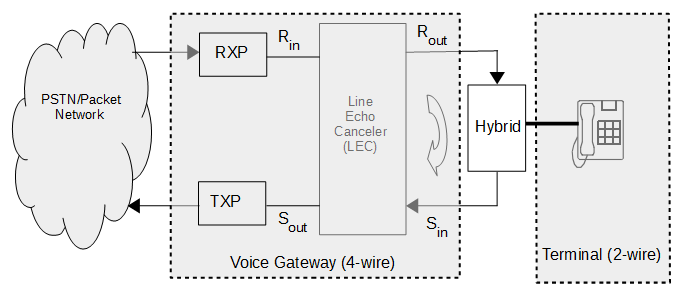|

|
|
Network or Line echo is generated due to impedance mismatch between 4-to-2 line hybrid
transformers located in the telephone central office or in an office PBX, resulting
in leakage (echo). This leakage causes a voice signal transmitted from terminal A to terminal B
to be reflected back to terminal A, delayed and attenuated. The result is that the user of that
terminal A hears his/her voice delayed by the line delay. If the line delay is short (less than
25 ms one way such as in national calls), the echo is not perceived as disturbing. As the line delay
increases, however, echo is perceived as annoying and disturbing so that natural conversation
becomes no longer possible. Long line or network delay occurs in many cases such as long
distance and international calls, as well as wireless, satellite, and VoIP network calls where
encoding, decoding, and buffering are all necessary.
Please refer to
this document for more information on the sources of echo in VoIP networks and their role
of network echo cancellers.
Line or Network echo can be removed using a Line/Network echo canceller. The echo canceller
employs an adaptive digital filter to estimate the echo and subtracts the estimated echo
from the echo contaminated signal. A high quality echo canceller must function properly
in all situation, and must therefore include several other processing modules besides the
adaptive digital filter to reduce any residual echo, and make sure the adaptive filter
does not diverge during double-talk.
|
|
PERFORMANCE
Our Line and Network Echo Cancellers have been optimized in quality, features, and performance based on extensive field testing and valuable customer
feedback over the years. It includes advanced features that are required in modern high end communication systems
such as fast convergence, low processing delay, robustness during double talk, automatic estimation and
compensation of initial delay, performance reporting, and much more.
Although many line/network echo cancellers on the market today pass all the G.168 tests, only a few can provide good quality
voice during double-talk. The sample audio files below demonstrate the audio quality of DSP ALGORITHMS echo canceller during
double-talk periods.
The female voice in the unprocessed signal (LEFT side) is the echo that must be removed, while the male voice is the voice of
the local call participant that must be preserved. The signal at the RIGHT side shows how the echo canceller can remove
the female voice entirely without distorting the male speech. The image at the left shows the spectral contents of the
unprocessed signal, while the image at the right shows the spectral contents of the processed signal. Click the images for
larger view.
FEATURES
- Low algorithm processing delay; defined by the user-adjustable block length.
- Complies fully with G.168-2012.
- Employs a robust and efficient block frequency domain adaptive algorithm.
- Provides superior and consistent single-talk echo reduction of 80 dB in any acoustic environments.
- Provides stable echo reduction of 40 dB or more during double-talk periods.
- Convergence rate up to 100 dB per second.
- Echo tail length is user adjustable to suit the application at hand without any limitations.
- High quality echo suppressor is also included which further reduces any remaining residual echo with negligible double-talk distortion.
- Echo suppressor can be enabled or disabled in real-time
- True Comfort Noise Generator that accurately estimates and tracks the background noise spectrum and level
- Works at any sampling frequency without any calibration or modification.
- Trivial to integrate due to its simple Application Programming Interface.
- Fully configurable. System designers have complete control on algorithm parameters.
- Already lab and field tested on several fixed-point and floating-point processors and digital signal processors.
- Supported on all major desktop, mobile, and embedded platforms.
- Floating-point and Fixed-point implementations optimized for several general purpose processors, microcontrollers, as well as digital signal processors are directly available.
DEMONSTRATIONS
Several demonstrations are available on different embedded, mobile, dsp, and desktop platforms.
To request one of those demonstrations please fill in this short form.
|